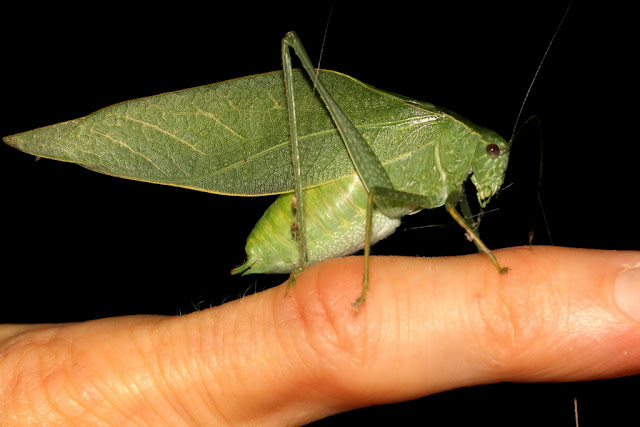Greater Angle-wings. People often recognize their “tic-tic-tic”
calls, which we hear not only in rural areas but also in the city where there’s
tall, old trees. They also have an additional, more emphatic “tsit!” call, but it’s
the “tic-tic-tics” that people remember.
The ”tic-tic-tics” aren’t at a steady tempo. They start a
little slower, then accelerate toward the end of the song.
The tone quality reminds me very much of claves, a Latin percussion instrument used in instrumental ensembles. (Claves produce a great tic-tic-tic when the two smooth, round wood sticks are tapped together. I can do a pretty convincing demonstration of the Greater Angle-wing song with them.)
The tone quality reminds me very much of claves, a Latin percussion instrument used in instrumental ensembles. (Claves produce a great tic-tic-tic when the two smooth, round wood sticks are tapped together. I can do a pretty convincing demonstration of the Greater Angle-wing song with them.)
Greater Angle-wings begin singing in our back yard in later
August each year, and they seem to live up in the tall pin oaks. We hear then
regularly near the driveway and above our little bungalow. This recording is from exactly that spot:
Occasionally, we’ll find one lower down so we can see him up close. This year, though, we had one that came to the back porch light in the evening.
Occasionally, we’ll find one lower down so we can see him up close. This year, though, we had one that came to the back porch light in the evening.
We met him on August 28, 2016. He was on small back porch near
the door, and he looked a little confused. He also had some webbing on him,
which I was mostly able to remove. He seemed fine and it was early in his
singing season, so we took a few photos and sent him on his way.
Two months later, I was in the back yard after dark, attempting to
find a few Jumping Bush Crickets to bring inside. It was late October, and
strong cold front was approaching. I could see lighting to the north. The
thunder was getting closer. Things were not going to go well for the crickets
and katydids who were still singing.
Soon, the wind gusts became disconcertingly strong. I heard some
smaller branches falling unnervingly close to me, so I abandoned my Jumping
Bush Cricket search and hurried to the back porch.
A male Greater Angle-wing was on the back porch door screen.
Was it the same one? I don’t know for certain, as I could also
hear another one singing up above the house, but it seemed oddly coincidental
to have another Angle-wing on the same back porch two months later.
I’d never had a large katydid like this one in the house
before, and I didn’t know what he’d need. I did have a larger terrarium that
was unoccupied at the moment, though, and I added twigs full of oak leaves that
had blown down in the gusty wind.
I gently dropped him into his leafy refuge, and he vanished.
How could an insect that large disappear in a terrarium?
They are outstanding leaf mimics. His color matched his oak
leaves, and his wings had venation the looked like that of plants.
In addition, he was old and had brown spots now – as did the oak leaves. Even his legs looked like leaf stems!
In addition, he was old and had brown spots now – as did the oak leaves. Even his legs looked like leaf stems!
For the week that this old katydid lived in the kitchen, we
practiced trying to find him. This project did not get much easier over time.
His camouflage was just too good.
He didn’t sing in the house - or at least never did so when we were awake. He was a visual rather than auditory experience for us, and he really was quite fascinating to watch.
He didn’t sing in the house - or at least never did so when we were awake. He was a visual rather than auditory experience for us, and he really was quite fascinating to watch.
He moved very slowly and carefully, and could stay motionless in his new location for hours. This would be a good strategy for avoiding avian daytime detection up in the trees, as it’s almost impossible to see them when they don’t move.
I gave him lettuce, a half of a grape on a stick, a small
slice of apple, and a half of an organic red raspberry to supplement his oak
leaves. I also misted his leaves with a
little water for moisture. He did seem to appreciate the apple and the
raspberry.
After a little over a week, he gradually faded away. I was
sad, but also appreciative of how much we learned from him about the way Greater
Angle-wings move and especially how they hide.











Beautiful photos and they sure do blend in with the leaves - that's probably why I have yet to see a Greater Anglewing in the wild. I have probably heard one without really noticing, thank you for demystifying their sound!
ReplyDelete